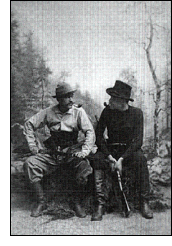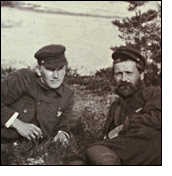 |
| Introduction |
| Poetry collecting |
| Lönnrot in Viena |
| Karelianism |
| Viena in the 1900's |
| Rune singers and collectors |
| Main page | Background | Villages | Revitalisation | Cultural tourism | Map | |
|
|
What ensued was an artistic movement that extended to virtually every sphere of artistic endeavor and drew its inspiration from the Kalevala and the nature and way of life of the song-lands. Artists headed for Karelia in search of inspiration, and in their wake came new generations of poetry collectors and researchers. The founders of this movement or, in a broader perspective, mode of thought that was later dubbed "Karelianism" included the visual artists Akseli Gallen-Kallela and Louis Sparre. They were the first to set off on pilgrimages to the "Land of Poems", but were soon followed by the sculptor Emil Wikström, the writers Juhani Aho, Eino Leino and Ilmari Kianto, the composers Jean Sibelius and P.J. Hannikainen, the architects Yrjö Blomstedt and Victor Sucksdorff, and a host of others.
The expeditions to the song-lands of the Kalevala inspired by Karelianism continued well into the 1920s, when the border between Finland and Russia was closed. It was not until the Second World War, when Finnish troops occupied part of Viena, that researchers were next able to visit the bardic villages. Subsequent developments led to the border being closed again for decades. |
 It
is no surprise that in the 1890s artists began to show interest
in the Kalevala and the bardic areas. Nationalism and Romanticism
were passions in the arts at that time. What better source of inspiration
could Finnish artists have for their work than the ancient poetry
of the Finnish people and the world of the bards who sang it?
It
is no surprise that in the 1890s artists began to show interest
in the Kalevala and the bardic areas. Nationalism and Romanticism
were passions in the arts at that time. What better source of inspiration
could Finnish artists have for their work than the ancient poetry
of the Finnish people and the world of the bards who sang it? One
particularly significant trip to Viena was that undertaken by Into
Konrad Inha and Kusti Karjalainen in the spring of 1894. The outcome
of their journey was incomparable: Inha's classic work "From
the Song-Lands of the Kalevala", his superb photographic accounts
of life in the region, and Karjalainen's Viena glossary, a lexicon
comprising some 10,000 words.
One
particularly significant trip to Viena was that undertaken by Into
Konrad Inha and Kusti Karjalainen in the spring of 1894. The outcome
of their journey was incomparable: Inha's classic work "From
the Song-Lands of the Kalevala", his superb photographic accounts
of life in the region, and Karjalainen's Viena glossary, a lexicon
comprising some 10,000 words.